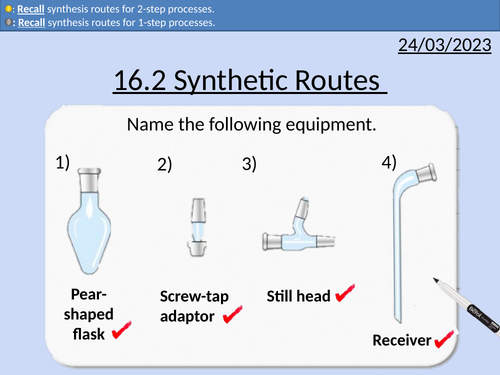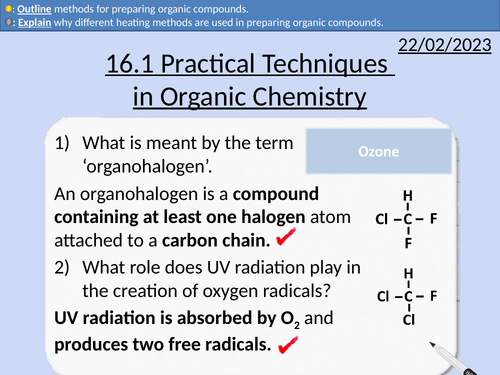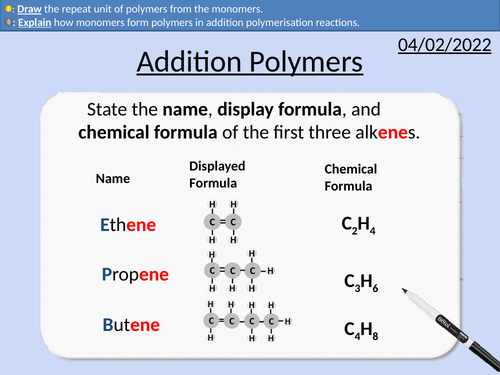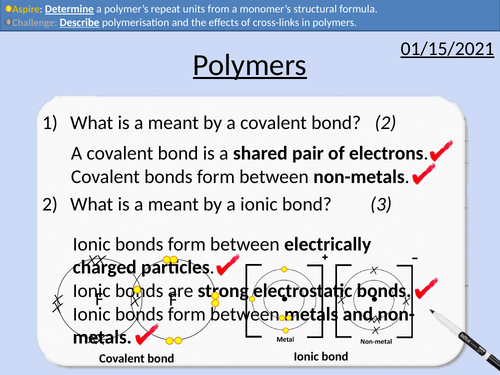504Uploads
186k+Views
77k+Downloads
All resources
Bundle

OCR A level Physics: Radioactivity
OCR A level Physics: Chapter 25 Radioactivity is apart of the Module 6: Particle and Medical Physics
All presentations come with worked examples, solutions and homeworks.
25.1 Radioactivity
25.2 Nuclear decay equations
25.3 Half-life and Activity
25.4 Radioactive Decay Calculations
25.5 Modelling Radioactive Decay
25.6 Radioactive Dating
Types of ionising radiation (alpha, beta-plus/beta-minus, gamma)
Penetration power and ionising power
Detecting radiation with a Geiger (GM tube) counter
Background radiation and correct count rates
Electric and magnetic fields affect ionising radiation
Cloud chambers
Typical speeds of radiation produced form nuclear decays
Conservation rules for nuclear decays
Nuclear notation
Alpha decays
Beta-minus and beat-plus decays
Gamma decays
Decay chains
The reason why radioactive decays are considered random and spontaneous
Rolling dice being a good analogue for radioactive decays
Definition of half-life
Determining half-life from a graph.
Calculating half-life from a table of data.
Activity of a sample in Bq
The decay constant derivation
Decay constant and half-life
Using exponentials to calculate activity and number of nuclei present
Solving Differential Equations (beyond A-level Physics course)
Iterative Method
Selecting appropriate time intervals
Comparing answers from the iterative method and exact solution.
State what isotopes of carbon are used in carbon dating.
Explain how carbon dating works.
Calculate the age of objects with carbon dating.
Bundle

OCR A level Physics: Magnetic Fields
OCR A level Physics: Chapter 23 Magnetic Fields is apart of the Module 6: Particle and Medical Physics
All presentations come with worked examples, solutions and homeworks.
23.1 Magnetic fields
23.2 Understanding magnetic fields
23.3 Charged particles in magnetic fields
23.4 Electromagnetic induction
23.5 Faraday’s law and Lenz’s law
23.6 Transformers
Attraction and repulsion of magnets
Rules for magnetic field lines
The magnetic field of Earth
Applying the right-hand cork screw rule
How to create uniformed magnetic fields
Solenoids
Fleming’s left hand rule
Determining the direction of force on a current carrying conductor
Calculating the magnitude of force on a current carrying conductor
Angles between the magnetic field and current carrying conductor
An experiment to determine the magnetic flux density of a field.
Apply Fleming’s left-hand rule to charged particles
Deriving an equation for the magnetic force experienced by a single charged particle (F = BQv)
Charged particles describing (moving) in circular paths in magnetic fields.
The velocity selector.
The Hall probe and Hall voltage.
Electromagnetic induction produces an induced e.m.f
Conditions to produce electromagnetic induction
How to increase electromagnetic induction
Magnetic flux density, magnetic flux, and magnetic flux linkage
Units of weber (Wb)
Magnetic flux density and magnetic flux linkage
Faraday’s Law
Lenz’s Law
Alternators and induced e.m.f.
Graphs of flux linkage and induced e.m.f.
Structure of transformers
Step-up and step-down transformers
The turn-ratio equation
The ideal transformer equation
Why transformers are used in the National Grid
Bundle

OCR AS level Physics: Laws of Motion
OCR AS level Physics presentations for module 3: Materials.
All presentations come with worked examples, solutions and homeworks.
This covers topics from Newton’s laws to conservation of momentum in two dimensions.
Bundle

OCR AS level Physics: Materials
OCR AS level Physics presentations for module 3: Materials.
All presentations come with worked examples, solutions and homeworks.
This covers topics from Hooke’s Law to Young Modulus.

OCR AS Chemistry: Synthetic Routes
OCR AS Chemistry: 16.2 Synthetic Routes
This PowerPoint is a whole lessons included with student activities, animated answers, homework questions with answers provided.
This lesson covers:
Functional Groups - Alkane, Alkene, Haloalkane, Alcohols, Carboxylic Acid, Ketone, Aldehyde, Ester, Amine, Nitrile.
One-step synthetic routes with reagents and conditions
Two-step synthetic routes with reagents and conditions
Bundle

OCR A level Physics: Stars
OCR A level Physics: Chapter 19 Stars is apart of the Module 5: Newtonian world and Astrophysics.
All presentations come with worked examples, solutions and homeworks.
19.1 Objects in the Universe
19.2 Life Cycles of Stars
19.3 Hertzsprung-Russell Diagram
19.4 Energy Levels in Atoms
19.5 Spectra
19.6 Analysing Starlight
19.7 Stellar Luminosity
The size of astronomical objects: Universe, Galaxies, Solar systems, Stars, Planets, Planetary satellites, Comets, Artificial planetary satellites
Comparing planets and comets
The birth of stars
Stars in equilibrium during the main sequence
Calculating mass in kg from solar mass
Life cycle of stars with a mass between 0.5 and 10 solar masses
Life cycle of stars with a mass above 10 solar masses
Pauli exclusion principle and electron degeneracy pressure
Red giants and white dwarfs
The Chandrasekhar limit
Red supergiants to black holes and neutron stars
Stellar nucleosynthesis
Definition of luminosity
Usual axis choice of a HR diagram.
Identifying the positions of the main sequence, white dwarfs, red giants, and red supergiants.
Description of how stellar evolution is shown in a Hertzsprung-Russell diagram
Atoms have different electron arrangements
Ground state energy
Bound electron states being negative
Converting between joules and electronvolts
Calculating the change of energy between energy states
Calculating a photon’s frequency and wavelength
The electromagnetic spectrum and wavelengths
Definition of spectroscopy
Electrons and energy levels
Continuous spectra
Emission spectra from gases
Absorption spectra from gases
Electromagnetic interference
Double slit experiment
Path and phase difference
Diffraction grating
The grating equation
Lines per millimeter to grating spacing
Maximum order, n
Maximum number of maxima
The electromagnetic spectrum, frequency/wavelength, and temperature
Black body radiation
Wein’s displacements law
Stefan’s law (Stefan-Boltzmann law)
Bundle

OCR AS level Physics: Quantum Physics
OCR AS level Physics presentations for module 4: Quantum Physics.
All presentations are full lesson PowerPoints with worked examples and homeworks with complete worked answers.
The Photon Model
Energy of a single photon
Converting from electron-volts to Joules.
Frequency of the electromagnetic spectrum
Determining Plank’s constant with LEDs
Threshold potential difference difference
Photoelectric Effect
Threshold frequency
Producing photoelectrons
Kinetic energy of photoelectrons
Linking frequency and wavelength
The electromagnetic spectrum, frequency and energy.
Einstein’s Photoelectric Equation
The photoelectric equation
Work function and Kinetic Energy
Determining work function from a graph
Determining threshold frequency from a from graphical analysis.
Determining Plank’s constant from graphical analysis.
Wave Particle Duality
deBroglie wavelength equation
Diffraction of electrons and protons
Comparing wavelengths of particles with different masses
Kinetic energy and wavelength
Bundle

OCR A level Physics: Circular Motion
OCR A level Physics: Thermal Physics apart of the Module 5: Newtonian World and Astrophysics.
All presentations come with worked examples, solutions and homeworks.
Bundle

OCR A level Physics: Capacitance
OCR A level Physics: Chapter 21 Capacitance is apart of the Module 6: Particle and Medical Physics
All presentations come with worked examples, solutions and homeworks.
21.1 Capacitors
21.2 Capacitors in circuits
21.3 Energy stored by capacitors
21.4 Discharging capacitors
21.5 Charging capacitors
21.6 Uses of capacitors
Electrical quantities, symbols, and units
SI prefixes and standard form
Definition of a capacitor
Structure of a capacitor
Calculating capacitance, charge, and potential difference.
Uses of capacitors in circuits.
Rules for capacitors in parallel (potential difference, charge, and capacitance).
Rules for capacitors in series (potential difference, charge, and capacitance).
Applying the rules in series and parallel.
Creating a circuit to calculate the charge stored on the capacitor.
Work done of a capacitor depends upon the initial potential difference and capacitance.
Work done is provided by the source of potential difference.
Deriving three equations for work done of a capacitor.
Exponential increase and exponential decay
Explaining how capacitors discharge through a resistor in parallel
Definition of time constant for a capacitor
Showing that time constant has units of seconds
Iterative method for finding how capacitors discharge
Using exponentials and logs.
Solving a differential equation (needed for A-level Maths).
Explaining how capacitors charge with a resistor in series
Explaining how 𝑉, 𝐼, or 𝑄, change with time 𝑡 for a charging capacitor.
Sketching graphs for 𝑉, 𝐼, or 𝑄, after time 𝑡 for a charging capacitor.
Calculating 𝑉, 𝐼, or 𝑄, change with time 𝑡 for a charging capacitor.
Calculating power output from a circuit containing a capacitor
A rectifier circuit - changing an alternating input to a smooth output
Bundle

OCR AS level Physics: Waves 1
OCR AS level Physics presentations for module 4: Waves 1
All presentations come with worked examples, solutions and homeworks.
This covers topics from wave properties to Snell’s law and total internal reflection.
Bundle

OCR A level Physics: Cosmology (Big Bang)
OCR A level Physics: Chapter 20 Cosmology (Big Bang) is apart of the Module 5: Newtonian world and Astrophysics.
All presentations come with worked examples, solutions and homeworks.
20.1 Astronomical Distances
20.2 The Doppler Effect
20.3 Hubble’s Law
20.4 The Big-bang Theory
20.5 Evolution of the Universe
Astronomical distances: light-years, parsec, astronomical unit
Astronomical angles - degree, arcminute, arcsecond
Parallax Angle
The definition of the Doppler effect
Changes in pitch of sound waves due to relative motion
Absorption spectra and electron energy levels
Red-shift and blue-shift absorption spectra
The Doppler equation
The condition for velocity for the Doppler equation
The Cosmological Principle
Hubble’s Observations
Hubble’s Law
Hubble’s constant and the gradient of a graph
Converting between km s-1 Mpc-1 into s-1
The expanding Universe model.
Georges Lemaître’s Theory
Evidence for the Big Bang Model
Hubble’s Law (expanding Universe)
Microwave Background Radiation
Source of the Microwave Background Radiation
Hubble’s constant and the age of the Universe
The evolution of the Universe from the Big-bang to 13.7 billion years later
The composition of the Universe
Experimental evidence for dark matter
Experimental evidence for dark energy

OCR AS Chemistry: Practical Techniques in Organic Chemistry
OCR AS Chemistry: 16.1 Practical Techniques in Organic Chemistry
This PowerPoint is a whole lessons included with student activities, animated answers, homework questions with answers provided.
This lesson covers:
Heating under reflux
Distillation
Re-distillation
Purifying Organic Products
Removing impure acids from organic compounds
Drying agents
Bundle

OCR A level Physics: Particle Physics
OCR A level Physics: Chapter 24 Particle Physics is apart of the Module 6: Particle and Medical Physics
All presentations come with worked examples, solutions and homeworks.
24.1 Alpha-particle scattering experiment
24.2 The Nucleus
24.3 Antiparticles, Leptons, & Hadrons
24.4 Quarks
24.5 Beta decay
Developments of scientific models
Thompson’s plum-pudding model
Rutherford’s nuclear (planetary) model
Rutherford’s experiment, observations, and conclusions
Using Coulomb’s law to find the minimum distance between particles
Nucleons
Isotopes
Nuclear notation
Atomic mass units (u)
Radius for atomic nucleus equation
Volume and density of atomic nuclei
The strong nuclear force
Antiparticles, their properties, and symbols
Particle and antiparticle annihilation
The four fundamental forces (strong nuclear, weak nuclear, electromagnetic, and gravitational forces) and their properties.
Definition and examples of hadrons and leptons.
The Standard Model of particle physics
Quarks, anti-quarks and their charges
Baryons and mesons
Properties of neutrinos
Nuclear notation
Nuclear decay equations
Beta-plus and beta-minus decays
Quark transformation
Bundle

OCR A level Physics: Nuclear Physics
OCR A level Physics: Chapter 26 Nuclear Physics is apart of the Module 6: Particle and Medical Physics
All presentations come with worked examples, solutions and homeworks.
26.1 Einstein’s Mass-Energy Equation
26.2 Binding Energy
26.3 Nuclear Fission
26.4 Nuclear Fusion
Mass-energy is a conserved quantity
Einstein’s mass-energy equation
Particle and antiparticle annihilate each other
Rest mass and increasing mass with increased kinetic energy
Interpretation of mass-energy equivalence
Definition of mass defect
Definition of binding energy
Binding energy per nucleon
Calculating mass defect, binding energy, and binding energy per nucleon.
Explaining nuclear stability
Fuels in nuclear fission reactors
Moderators and thermal neutrons
Conservation of mass-energy
Energy released in fission reactions
Control rods
Nuclear waste management
Conditions for nuclear fusion
Binding energy and released energy
Bundle

OCR A level Physics: Gravitational Fields
OCR A level Physics: Gravitational Fields is apart of the Module 5: Newtonian world and Astrophysics.
All presentations come with worked examples, solutions and homeworks.
18.1 Gravitational Fields
18.2 Newton’s law of gravitation
18.3 Gravitational field strength for a point mass
18.4 Kepler’s laws
18.5 Satellites
18.6 Gravitational potential
18.7 Gravitational potential energy
The terms: eccentricity, aphelion, perihelion, astronomical unit
Kepler’s First Law
Kepler’s Second Law
Kepler’s Third Law
Graphs of T^2 against r^3 to determine the gradient (constant of proportionality, k).
Equating (4π)^2/𝐺𝑀 to the gradient (constant of proportionality, k)
Key features of geostationary and low polar orbit satellites
Conditions for stable orbits for satellites
Applying Kepler’s laws to the orbits of satellites
Radial and uniformed field
Definition of gravitational potential energy
Deriving escape velocity
Force-Distance graphs for gravitational fields
Center of mass and treating spherical objects as point masses
Gravitational fields
Definition of gravitational potential
Applying the gravitational potential equation
Graph of gravitational potential against distance (V against r)
Combining gravitational potentials from more than one mass
Bundle

OCR A level Physics: Electric Fields
OCR A level Physics: Chapter 22 Electric Fields is apart of the Module 6: Particle and Medical Physics
All presentations come with worked examples, solutions and homeworks.
22.1 Electric Fields
22.2 Coulomb’s Law
22.3 Uniform electric fields and capacitance
22.4 Charged particles in uniformed electric fields
22.5 Electric potential and energy
Electric field line pattern from point charges, uniformly charged objects, and capacitors.
Rules for electric field lines
Interacting field lines for attraction and repulsion
Detecting electric fields with a charged gold leaf
Definition of electric field strength
Explaining that electric field strength is a vector with magnitude and direction
Apply the equation for electric field strength
Electric force related to the product of charge and square of the separation
The constant of proportionality 𝑘
Permittivity of free space
Experiment for investigating Coulomb’s Law
Electric Field Strength and Coulomb’s Law
Liquid crystal displays (LCDs)
Electric field between two charged parallel plates
Deriving an equation for electric field strength of a parallel plate capacitor.
Accelerating charged particles in a uniformed electric field
Capacitance of a parallel plate capacitor with an insulating (dielectric) material - relative permittivity
Millikan’s experiment
Equations for constant acceleration
Maximum kinetic energy of a charged particle in a uniformed field
Sketching trajectories for charged particles in uniformed fields
Calculating velocities for horizontal and vertical components
Definition of electric potential energy
Definition of electric potential.
Definition of electric potential difference.
Using a force-distance graph to determine electric potential energy
Using electron-volts and joules in calculations
Capacitance of an isolated charged sphere

OCR AS Chemistry: Electrophilic Addition in Alkenes
OCR AS Chemistry: 13.4 Electrophilic Addition in Alkenes
This PowerPoint is a whole lessons included with student activities, animated answers, homework questions with answers provided.
This lesson covers:
Electrophile molecules
Electronegativity
Reaction mechanisms for addition reaction of alkenes and hydrogen halides
Carbocations and stability
Markownikoff’s Rule

GCSE Chemistry: Addition Polymers
This PowerPoint presentation with worked examples and student questions covers:
Prefixes mono- and poly-
Alkanes and alkenes functional groups
Saturated and unsaturated carbon bonds
Addition polymerisation reactions
Conditions needed for polymerisation reactions
How monomers form polymers
Repeat units and monomers

GCSE Chemistry: Polymers
This PowerPoint presentation with worked examples and student questions covers:
• State what is meant by mono- and poly-.
• Describe polymerisation and the effects of cross-links in polymers.
• Determine a polymer’s repeat units from a monomer’s structural formula.
Bundle

OCR A level Physics: Thermal Physics
OCR A level Physics: Thermal Physics apart of the Module 5: Newtonian World and Astrophysics.
All presentations come with worked examples, solutions and homeworks.




















